|
THE STATE EDUCATION DEPARTMENT / THE UNIVERSITY OF THE STATE OF NEW YORK / ALBANY, NY 12234 |
TO: The
Honorable the Members of the Board of Regents
FROM: Theresa
E. Savo
COMMITTEE: Full
Board
TITLE OF ITEM: 2005-2006 Development Process
DATE OF
SUBMISSION: June
25, 2004
PROPOSED
HANDLING: Discussion
RATIONALE FOR
ITEM: The
Third Step in the 2005-2006 Budget Development Process
STRATEGIC
GOAL: Goals
1-6
SUMMARY:
The 2005-2006 budget is being developed using the budget development process outlined below. The third step in the process (highlighted below) calls for the Board to:
· review the existing three-year initiatives against established initiative outcomes and evaluation criteria (March 2004);
· evaluate the 2005-2006 initiatives proposed by the program offices using the established criteria in the Regents Standing Committees (June 2004);
· discuss the proposed 2005-2006 budget initiatives with the full Board of Regents (July 2004); and
· act on the "Bluebook" 2005-2006 Budget Proposal (September 2004).
The attached materials were reviewed in the respective Standing Committee meetings at the June 2004 Board of Regents meeting:
1) A Summary of Request Over 2004-2005 Level Funding by Fund Category (Aid to Localities, State Operations, Capital).
2) A Summary of Request Over 2004-2005 Funding by Program Area including narrative details in support of proposed increases.
If you have questions, please call.
Attachments
PROPOSED
2005-2006
BUDGET INITIATIVES
June 2004
Table of
Contents
DEPARTMENT SUMMARY OF REQUEST OVER LEVEL FUNDING
DEPARTMENT SUMMARY OF REQUEST OVER LEVEL FUNDING
Budget Initiatives
for Consideration in 2005-2006
Summary of Request Over Level Funding
($ THOUSANDS)
2005-2006
PROPOSED BUDGET INITIATIVES
Strengthened
Accountability to Ensure Improved Student Achievement and Effective Use of
School Resources
Raising student achievement in the State’s neediest
school districts requires effective use of school resources. This requires the use of good information on
student achievement and school resources at all levels of education.
·
The education system
needs to be able to track the achievement of individual students as they move
through the system to determine what works and for whom.
·
School personnel need
adequate and predictable revenues to support educational programs.
·
They need to engage in
long-range planning to ensure school improvement and good financial
condition.
·
The public needs good
information in order to ensure that districts are providing the level and type
of education they desire and that desired outcomes are actually being achieved
at a reasonable cost.
·
The State Education
Department needs good information on student achievement and school resources
to direct technical assistance and monitoring efforts on school improvement, to
distribute State Aid to school districts, and to oversee school district
financial condition.
Each of these actions is required for school
accountability. The State Education
Department has developed a variety of systems over the past few decades that
provide information, albeit to a limited extent, on the effective use of school
resources to raise student achievement.
Recent advances in technology provide the potential to improve data and
data systems, thereby enhancing school accountability. These information systems need to be updated
and expanded to:
·
Enable individual
student tracking;
·
Create a unified system
to manage the collection, processing, maintenance, publication and projection
of all State Aid related data; and
· Provide a comprehensive review of school district financial condition in order to ensure good fiscal health in support of quality educational programs.

Updating and expanding these systems is part of
streamlining school district planning and reporting. The State Education Department receives over 125 plans,
applications and reports from school districts each year. Some of these are outdated and many have
redundant elements. Many are focused on
processes that school districts use, which tell little about the results they
accomplish. In order to streamline
school district planning and reporting so that it is efficient and helps school
districts focus on and improve student achievement results, good information
systems are needed.
This budget request seeks $9 million to:
·
Build a statewide
student data system;
·
Create a unified State
Aid Management System; and
·
Create and implement a
Financial Condition Indicator System.
These systems
will contribute in fundamental ways to accomplishing Regents goals to:
·
Have all students meet high standards for academic
performance;
·
Have all educational institutions meet high performance
standards;
·
Make education, information and cultural resources available
and accessible to all people; and
·
Ensure that resources under our care are used or maintained
in the public interest.
Strengthened
Accountability to Ensure Improved Student Achievement and Effective Use of
School Resources
Build a Statewide Student Data System
Teachers,
school administrators and state officials rely on data to assess the quality
and outcomes of the State’s educational system at levels ranging from the
individual student to the State as a whole.
A
statewide data system will meet a variety of educational and accountability
needs. It will:
·
Radically transform the way educational data are collected,
maintained and used and create greater capacity to raise the achievement of all
students in New York;
·
Reduce redundant data collection and facilitate reporting by
integrating Department data systems; and
·
Inform educational policy and provide accountability for
federal, State, and local institution and program management.
System Components:
The statewide student data system consists of the
following components:
·
A stable, statewide unique identifier assigned to
each student.
·
A database of student demographic, performance and
program participation data that is accessible to teachers and administrators,
and also
supports
State and Federal reporting.
·
User friendly, reports and analytical tools
to help teachers and administrators use data to improve instruction.
·
Support and technical
assistance to school districts to help them create and use quality data.
The
system will:
·
Provide the data necessary to implement New York
State’s System of Accountability for Student Success.
·
Enhance the State’s ability to audit critical data,
such as attendance, enrollment and free- and reduced-price lunch data used to
allocate State aid to schools and the performance data used for school
accountability purposes.
·
Substantially ease the burden on local
school districts by reducing redundant data collection and facilitating
reporting by integrating SED data systems.
·
Replace at least five separate Department data
systems related to student education.
·
Reduce the time between data collection and ability
to access and use data by at least two months.
Requested Resources
-
Annual maintenance fee for
statewide student data repository software: $1.5 million
-
Analytical and
reporting resources to provide teachers, administrators and policy staff with
useable
data analyses: $700,000
- Support to districts for maintaining and using data: $1.5 million
Create a Unified State Aid Management System
The current mainframe computer system used by the State
Education Department consists of over two million lines of code and a complex
network of programs that have evolved over the past 20 years to accommodate
State Aid formula changes introduced by new legislation each year.
Under the present system:
·
Different software is used to produce
related information;
·
Duplicate data is maintained on
multiple systems;
·
Maintenance is labor intensive and
overly complex;
·
Access is difficult and limited to only
a few;
·
Modeling capacity is limited and time
consuming; and
·
Management does not have the tools
necessary to do timely and comprehensive data analysis.
The State Aid
Management System (SAMS) will address the shortcomings of the current system by
providing:
·
A single point of access to State Aid
data;
·
The means for enabling the Department
to collect information from school districts across the State more effectively;
·
The capability to analyze districts’
fiscal needs;
·
A streamlined method for distributing
State and Federal funds to school districts; and
·
Modeling capability during the annual
State budget process to inform and assist the Executive and the New York State
Legislature as they address State education funding requirements.
Requested Resources
- $5 million annually
to provide funding for this multi-year effort.
Develop
and Implement a School
District Financial Condition Indicator System
Typically
the general public has little awareness of school district financial condition
until a crisis emerges. By then the
choices are often limited and can require painful expenditure cuts or tax
increases. The best prevention against
fiscal emergencies is regular monitoring of district financial health, and
appropriate budget adjustments. Good
information on school district financial condition results in good
communication about cost-effective ways to sustain quality educational
programs, which helps to protect the public’s investment in its schools and to
gain its support for future funding.
The following chart shows how an actual school district depleted its savings (fund balance) and consistently overspent (surplus/deficit), plunging itself into fiscal stress. Careful monitoring of fiscal indicators will help a district and the State to divert such stress before it occurs.
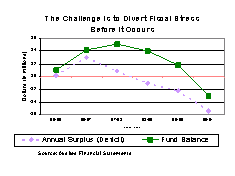
The
measurement of school district financial condition:
In order to
facilitate regular monitoring of school district fiscal health, the State
Education Department has begun to report on indicators of school district
financial condition. The Department
reported on a small number of indicators of short-run financial condition. This fostered a positive dialogue with
school districts and caused the Department to turn to the Education Finance
Research Consortium for additional development. Previously, the Education Finance Research
Consortium, with financial assistance from NYSED, contracted with researchers
to begin development of a Financial Condition Indicator System (FCIS) and to
survey school districts to determine the financial stability of school
districts across the State.
A viable
conceptual system has been developed for SED and shared
with school business officials, school board members and administrators from
the big city school districts, Yonkers, Syracuse, Rochester and Buffalo. The response from school districts officials
has been favorable. Many districts want
the system fully developed and put in place now.
The School
District Financial Condition Indicator System is planned to become a critical
application at NYSED to help school districts maintain good financial standing
to support quality educational programs for students. The system will provide a comprehensive analysis of a school
district’s financial condition and economic environment and will be used by
NYSED and school district officials for three main purposes:
·
Long range financial planning tool for school
district officials.
·
Early warning system for State oversight of school
districts to prevent financial distress.
·
Public information tool concerning the management of
public resources to achieve educational goals.
The goal is
to fully implement the FCIS in three phases. They are as follows:
1.
Further development of the system
-
To pilot long-range planning and early warning
tools
- For use by the Big 5 Fiscally dependent city school districts
-
To develop and pilot the public information tool
2.
Development of a business plan and information technology
protocols for implementing the system
3.
Implementing the system
–
Full implementation with all NYS school districts
for long range planning and early warning system
–
Implementation of a public
information tool.
The implementation and
maintenance of the FCIS will involve designing the method of presenting the
FCIS (consisting of approximately 50 indicators), designing software to
implement the collection and analysis of data from over 700 school districts,
and maintenance of the system.
Cost
benefit
The cost of developing and implementing the FCIS
will be far less than that expended by the State on school districts in fiscal
stress. If the system is effective at
preventing stress, it will more than pay for itself.
·
The measurement of financial
condition and use of such data by the public school districts and the State
will help improve the fiscal health of schools and the cost-effective
use of district resources.
·
The system will save
taxpayers considerable amounts
of money by avoiding the need
for special legislative assistance when districts require financial assistance.
Benefits to school districts
The system will:
·
Provide
financial information to assist in comprehensive planning and other reform
efforts to close the student achievement gap;
· Facilitate the exchange of information to
districts on “best practices” in financial and capital management that can help
them increase the effective use of existing dollars.
·
Identify
factors associated with financial distress, which can help indicate possible
corrective action the district may take in the short run and long run.
·
Identify districts in
financial distress because of factors outside their control. This can help make the case for additional
State dollars or reform of the school aid formula such as simplification or
greater equity and adequacy.
·
Enhance
communication within the school district management team of superintendent,
school business official and school board.
The system can serve as a tool to communicate the status of the school
district’s financial condition including trends that may lead to fiscal stress. This will lead to corrective actions that
balance student and taxpayer equity while providing sustainable educational
programs.

School Board Members, Superintendent and Business Official Working
collaboratively on the school district budget.
Enhanced
audit capacity
Results
of the indicator system can assist the State Education Department and the New
State Office of the State Comptroller in auditing school districts to ensure
that public resources are used in the public interest. Information from the
system will enhance the identification of high-risk school districts that stand
to benefit the most from an audit. The information can also be used to pinpoint
specific areas of concern for individual school districts. Additional audit
resources may be necessary to provide audit services to identified high-risk
districts.
Requested Resources
1.
Further
development:
·
2005-2006:
$300,000
·
2006-2007:
$300,000
2.
Development
business plan
·
2007-2008:
$750,000
·
2008-2009:
$750,000
3.
Implement
and maintain
·
2009-2010
and thereafter: $2.0 million
(Includes
$222,000 for additional audit staff)
Total Requested Resources:
-
FY
2005-2006 - $9,000,000
Future
Budgetary Needs

Parent Involvement Advocacy
The
No Child Left Behind Act of 2001 holds schools accountable for results, gives
parents greater choice and promotes teaching methods that work. The parental involvement provision in Title
I stresses the importance of ongoing, meaningful communication between school
and home and emphasizes the rights of parents to have information that will
enable them to make well-informed decisions and share responsibility in the
development of effective schools. The Department must therefore continue to
strengthen and support parental involvement in all aspects of education.
A parent involvement program will enable the
Department to meet the following goals:
·
Provide technical
assistance and support to local school districts to enable districts to
implement effective parent involvement activities that support student
achievement;
·
Ensure that parents
receive timely information, in a language they understand, on student and
school improvement;
·
Disseminate information
on effective parent involvement strategies and programs; and
·
Provide parents with
the information and skills they require to effectively support and advocate on
behalf of their children. Build capacity in schools to increase parental
involvement in all activities designed to improve student achievement.
Funds would support work
with schools on increasing parental involvement. Proposed activities to be funded include:
·
Establish regional
parent resource centers to provide support to schools and families to develop
and implement innovative parent involvement programs. In New York City, the downstate technical assistance center would
work in conjunction with the ten regional districts and the central board and
serve as a resource to building level parent involvement coordinators.
·
Establish a statewide
information hotline for parents.
·
Support provision of
services by SED staff.
The expenditure of
these funds will result in:
·
Higher student
achievement for all students,
·
Increased attendance
and fewer student behavioral disruptions, and
·
Increased public
support for quality education.
Requested Resources
·
$5 million per year for
three years. Ten percent would be
allocated to fund direct provision of services by SED staff.
New York State
Summer Institutes
For 34
years, the New York State Summer School of the Arts (NYSSSA) has served
students from every area of the State who represent New York’s economic,
cultural and racial diversity, identifying tomorrow’s leaders in the arts and
providing them with intensive, pre-professional training and career development
opportunities. Over 15,000 students
have participated in this legislative initiative. The program’s success has
been demonstrated by former students’ achievements with top professional
companies all over the world and individual testimonials documented in yearly
alumni surveys.

“Absolutely one of the most intense, thrilling, different and influential experiences of my life! One of the few times I felt that I was actually an "artist" - total immersion in theatre, with talented peers and outrageous teachers. I was more free to experiment and examine myself than at any other time in my life.” Daniel Gerson, ‘83
The
Summer School of the Arts has operated on the same level of State funding
($690,000) since 1994. In that time,
there have been increases in all areas of program costs, but most especially in
the cost of room and board, facilities rental and transportation. These costs, which represent 2/3 of the
overall expenses, have risen by 35 percent over the past ten years. On the other hand, the artistic faculties of
each school, as well as the residential life staff needed to ensure the health
and safety of students, have received minimal, if any, increases in
compensation.

“NYSSSA
influenced me in ways so deep that I don’t even have the words for how it did.
I know that would not feel the way I do right now about myself and the world of
dance if it weren’t for the NYSSSA School of Dance and Carolyn Adams.” Erin Cowley, ‘96
The
formula for operating NYSSSA is an equal share of State Funds and Special
Revenue, which is derived from student tuition. To compensate for these rising costs, it has been necessary for
NYSSSA to raise the Special Revenue strand by increasing tuition approximately
10% and decreasing tuition assistance by 23%.
In 1994, tuition assistance was 33%; the current spending plan calls for
tuition assistance to be 10%. NYSSSA
continues to ensure that the programs are still accessible to all New York
State students, as per the original legislative intent. However, the current funding levels are now
limiting the program’s ability to ensure diversity among both students and
staff. Many families, especially middle-income ones, are being required to pay
a significant amount in tuition, thus forgoing other educational opportunities.
“Their financial aid program made it happen for me!” Stefon Harris, ’88, Blue Note artist
NYSSSA
BUDGET COSTS
·
Room & Board,
Facilities and Transportation – 66%
·
Other (printing,
publicity, administration) – 7%
·
Auditions – 3%
·
Personnel – 24%
In order to maintain the integrity of the program and
to ensure the health and safety of students, an increase in funding is
essential. An increase of $200,000 enables the program to:
·
return tuition
assistance to a level that ensures equity of access for all of New York’s
students.
·
provide appropriate
compensation for artistic and residential life staff.
·
provide funding for the
rising costs of room and board, as well as transportation and facilities
rental.
“Artistic Director Russell Stanger said, “You will think of your life as before NYSSSA and after NYSSSA.” He was absolutely right.” Julianne Kelly, ‘85
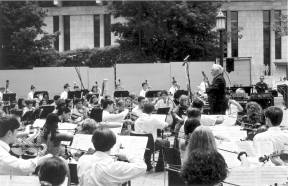
Resources Requested - $200,000
Mandated Needs:
Education of Native Americans
The
Commissioner of Education, by law, has responsibility for overseeing the
education of Native American students residing on reservations in New York
State. Pursuant to Sections 4101 (1)
and (2) of Article 83 of Education Law, the Commissioner contracts with school
districts for the tuition, transportation and maintenance of three, State-owned,
reservation school buildings in the State.
Additional funding of
$11,700,000 for prior year liabilities and $3,172,000 for the 2005-2006 school
year program for a total increase of $14,872,000 is requested to meet this
need.
NONPUBLIC SERVICES AID
Chapter
507 of the Laws of 1974 requires that nonpublic schools be reimbursed for the
actual costs they incur in providing required services to the State. These services include the administration of
State testing and evaluation programs and participating in State programs for
reporting basic educational data.
Additional
funding is requested to meet the costs of inflation, continue expanded
component re-testing of State exams, NAEP testing in nonpublic schools under
NCLB, continued administration of NYSESLAT, and implementation of new attendance
regulations.
SCHOOL HEALTH
AND SAFETY PROGRAM
The New York State Education Department’s Office of
Facilities Planning is statutorily mandated, as the New York State Code
Jurisdiction on public school property, to ensure the health, safety and well-being
of the 2.8 million public school students and staff. With the increasing
need to repair, renovate, and replace school facilities now approaching an
average age of 60 years, over 2,000 capital project building permits are
processed annually. The Office also oversees programs such as Rebuild
Schools to Uphold Education (RESCUE), annual fire safety inspections at over
6,000 school facilities, and assists with Project SAVE.
The Department requires an additional $400,000
annually to strengthen technical assistance, compliance monitoring and the
capital building permit review process.
HIGHER
EDUCATION AND THE PROFESSIONS
2005-2006
PROPOSED
BUDGET INITIATIVES
Priority Budget Initiatives
Regents
Goal 3:
"The public will
be served by qualified, ethical professionals who remain current with best
practice in their fields and reflect the diversity of New York State."
Teachers of Tomorrow
Research shows that a certified teacher is
the single most important factor in improving student achievement. Yet only 9,000 of approximately 18,000 new
teachers seek employment in New York State public schools each year. The Teachers of Tomorrow program:
·
attracts qualified
teachers to hard-to-staff schools and hard-to-staff subject areas
·
recruits and prepares
second career teachers and paraprofessionals through alternative teacher
certification programs
·
supports new teachers
through first-year teacher support, thereby reducing attrition and facilitating
the transition to teaching

To assist high-need school districts recruit and retain certified teachers, Teachers of Tomorrow provides:
·
certification stipends
and tuition reimbursement to help teachers with interim licenses and teachers in hard-to-staff schools meet
certification requirements
·
recruitment incentives
to new teachers in teacher shortage or subject shortage areas
·
summer teaching
experiences to new teacher candidates
·
opportunities for
hard-to-staff schools to recruit national board certified teachers
Teachers of Tomorrow Helps to Recruit and Retain Teachers for High-Need
Schools
In
its first three years (2000-2003), the Teachers of Tomorrow program:
· Provided 39 high-need,
low-performing school districts in New York State with funds to recruit 7,247
new teachers in hard-to-staff schools and subject areas.
·
Assisted high-need,
low-performing districts by providing them with the resources to permanently
certify 4,977 existing teachers.
·
Advanced 5,920
temporarily licensed teachers to provisional certification.
·
Provided resources for
1,572 pre-service teachers to receive internships in urban settings (available
in the Big 5 school districts - New York City, Yonkers, Buffalo, Rochester and
Syracuse).
To date, 21 New York State colleges have prepared
over 4,000 second career individuals for teaching positions through Teachers of
Tomorrow’s alternative certification programs.
Invest in Success: Support a
Program that Works!
Teachers of Tomorrow has successfully helped
hard-to-staff school districts recruit, prepare, and retain qualified teachers.
New Teachers Recruited through TOT Programs:
-
2000-2001 – 1,706
-
2001-2002 – 1,596
Teachers Retained with TOT incentives
-
2000-2001 – 5,486
-
2001-2002 – 2,419
Teachers of Tomorrow will continue to help close the
gap by improving the educational outcomes of our students in the lowest
performing school buildings. Invest in
success by expanding Teachers of Tomorrow --
Encourage Partnerships to Help Prepare and Recruit Teachers and
Paraprofessionals
Through a competitive four-year grant program, expand
Teachers of Tomorrow to provide funds to hard-to-staff school districts that
develop partnerships to recruit, prepare, support and retrain teachers through
an alternative teacher certification program. As many as 15,000 teachers could
be prepared over four years (i.e., three cohorts of 5,000 teachers taking two
years to complete the program). Each
partnership would provide matching funds to support the program. School districts may use these funds to
recruit new teacher education candidates from colleges in New York State.
Also, expand Teachers of Tomorrow to allow
paraprofessionals and candidates holding a Transitional–B certificate to
participate in the program.
Requested
Resources
·
2005-2006 School Year - $36 million
·
2006-2007 School Year - $36 million
·
2007-2008 School Year - $36 million
Support New Classroom Teachers
According to the Education Trust, students taught by inexperienced teachers for multiple years have lower achievement rates than their counterparts taught by experienced teachers.
Expand Teachers of Tomorrow to encourage entry-level teacher
support programs. Provide funding to
districts with programs enabling veteran skillful teachers to deliver support
to novice teachers.
·
Reduces
teacher turnover
·
Improves
teacher quality
·
Helps raise student
achievement
The end result:
increased teacher retention and increased teacher effectiveness. The exodus of beginning teachers from the classroom ranges
from 30% to 50% - most departing in the first three years. The problem is most critical in urban
schools. Teacher retention rates among beginning teachers with support are
significantly higher than those of beginning teachers without support.
Requested Resources
·
2005-2006 School Year - $52 million
·
2006-2007 School Year - $52 million
·
2007-2008 School Year - $52 million
Future Budgetary Needs
Regents Goal 1
“All
students will meet high standards for academic performance and personal
behavior and demonstrate the knowledge and skills required by a dynamic world.”
Invest in
Opportunity Programs – they work!
Higher Education Opportunity Program
(HEOP)
The Higher Education Opportunity
Program (HEOP) provides access to and financial support for higher education to
students who do not meet the regular entrance requirements and are economically
disadvantaged. HEOP is one of a few proven strategies for helping to reduce
youth underemployment and unemployment in the State.
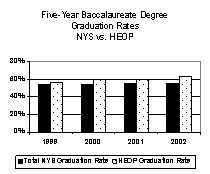
Outcomes
· 28,613 HEOP students have graduated since 1969.
·
Of the 1,013 HEOP graduates in 2002-2003,
68%
were employed directly after graduation, enrolled in graduate or professional
school, or matriculated at a senior college or another
institution.
· Graduation rates for Black and Hispanic HEOP participants are consistently higher than for regularly admitted Black and Hispanic students.
Requested Resources
An additional $5.5 million for a total of $27.5
million is requested to serve 6,250 (FTE).
This aid will:
·
Increase
academic support; and
·
Increase
supplemental financial assistance.
Liberty Partnerships Program
The Liberty Partnerships Program (LPP) provides
at-risk students with services designed to improve their ability to graduate
from high school and enter postsecondary education and the workforce. LPP helps to establish collaborative and
supportive partnerships between postsecondary education institutions, public
and non-public K-12 schools, parents, and other stakeholders. There are 57
Liberty Partnerships Programs serving over 14,000 students living in urban,
rural and suburban communities.
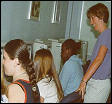
Keys to Success
·
Year-round programs and
services that promote educational and personal excellence among at-risk youth.
·
Effective teaching and
learning experiences throughout the K-16 continuum.
·
Professional
development opportunities that facilitate innovations in academic and social
intervention.
·
Collaborative community
activities genera-ting systemic and sustained resources for at-risk students
and high-need schools.
·
Parent/extended
community involvement.
Outcomes
·
The annual dropout rate of LPP students is under 2%; compared to the
statewide rate of over 5%.
·
Approximately 1,500 high school graduates in the LPP go on to
postsecondary education institutions each year.
·
Through
relationships with partners, Liberty
Partnerships Programs at the State and local levels have been able to leverage
expanded resources for students and partner schools.
Requested
Resources
An
additional $7.25 million for a total of $18.75 million is requested to address
the challenges to at-risk student achievement.
The success of the program has created a backlog of students who desire
to enter the program. Additional
funding will provide opportunities to:
·
Increase students
served by 1,200.
·
Reduce student/staff
ratios.
·
Strengthen professional
development for staff and faculty.
·
Expand
use of technology to improve student/program performance.
Science and Technology Entry Programs:
Promoting Careers in Math, Science, Technology, and Health
·
The Science and Technology Entry Program
(STEP) helps to increase the number of historically underrepresented and
disadvantaged students prepared to enter college, and improve their
participation rate in mathematics, science, technology, health-related fields
and the licensed professions.
·
The Collegiate Science and Technology Entry
Program (CSTEP) works to increase the number of historically underrepresented
students who enroll in and complete undergraduate or graduate programs leading
to professional licensure or careers in mathematics, science, technology (MST),
and health-related fields.

Outcomes
·
In 2002-03, 96% of STEP
graduates enrolled in college
·
Nearly half of college-going
graduates of the STEP actually pursued careers in math, science, technology,
and health in 2002-03.
STEP Compared to State Averages -
Regents Diploma
STEP - 73%
State - 52%
Minority - 24%
College-Going Rate
STEP - 94%
State - 81%
Minority - 67%
·
In 2002-03, 78% of college
seniors in the C-STEP program graduated.
·
20% of C-STEP participants enrolled in
graduate/professional school in 2002-03; 31% were employed in math, science,
technology, or health-related fields.
·
44% of C-STEP students achieved
a 3.0 or better G.P.A in 2002-03.
The STEP program serves
over 5,500 students per year and the C-STEP program serves approximately 3,500
students annually. We can’t stop here! Proportionate
representation of the New York State school population would require that an
additional 3,077 minorities earn bachelor degrees in math, science, technology,
and health fields. We are requesting
additional funds to serve more students.
Requested
Resources
An
additional $2.0 million for a total of $12.0 million is requested to serve
12,100 students.
·
This
increase will produce 334 additional minority MST bachelor degrees annually
through CSTEP and 148 additional minority students enrolling in college and
majoring in MST fields annually through STEP.
Regents Goal 2
“All educational institutions will meet
Regents high performance standards.”
College and University Investment Program
New York
State has a tremendous resource within its higher education system which is a
critical partner in meeting the State’s workforce and economic development
needs as well as meeting the educational needs of its citizens. The higher education system is richly
diverse, with:
·
266 colleges and
universities;
·
a wide variety of
institutions in the public, independent and proprietary sectors serving every
geographic region of the State;
·
institutions focused on
specific needs of different populations, including vocational education,
liberal arts and sciences, graduate level study, health care and the arts;
·
over 25,000 registered
programs in these institutions leading to degrees or certificates;
·
over one million
students enrolled in the State’s colleges on an annual basis;
·
over 200,000 degrees
earned each year at our institutions;
·
one of the highest
college-going rates in the nation (second only to Massachusetts);
·
the nation’s largest,
need-based grant aid program for students which helps keep our college-going
rates high; and
·
a statewide graduation
rate for undergraduates that is at or above national rates.

The
College/University Investment Program
builds upon the strength and diversity of New York’s system of higher education
to help meet additional workforce, economic and societal needs. This program
will provide grants to institutions of higher education to:
·
assist hard-to-staff
schools train, recruit, and retain teachers prepared to teach all children to
Regents learning standards;
·
increase collaboration
between liberal arts faculty and schools of education faculty to improve
teacher preparation at the master’s degree level;
·
initiate Summer
Training Institutes to help college faculty use information technology to
improving teaching and learning;
·
support Summer Training
Institutes that pair community college faculty with four-year college faculty to
help enrich freshman survey courses at community colleges;
·
create partnerships
between colleges and low-performing school districts to ensure that teacher
preparation meets the needs of the students they are being prepared to serve
and to enhance professional development activities for all teachers;
·
continue to explore the
most effective educational strategies for preparing second career individuals
to meet the needs of our school districts through alternative certification
processes;
·
provide scholarships
for students willing to teach in hard-to-staff subject areas and hard-to-staff
schools;
·
develop a closer link
between the higher education system in New York and the global scientific
community by providing fellowships for international doctoral and post-doctoral
candidates in the sciences; and
·
support exchange
programs for students in small liberal arts and sciences colleges to enrich
their studies in related fields.
Resources Requested:
·
$12 million for five years.
Statutorily Mandated Needs:
Aid to Independent
Colleges and Universities
The
annual entitlement for each institution is based on the number of earned
degrees conferred the previous year.
The
current rates are $600 per associate degree,
$1,500 per baccalaureate degree, $950 per master’s degree, and $4,550
per doctoral degree. Since 1990-1991,
the program has not been fully funded.
In 2003-2004, the State Budget provided $44,250,000 or 33% of full
funding.
Of the
142 independent degree-granting institutions in New York State, 101 participate
and receive Bundy Aid.
An additional $3 million for a total of $47.25
million is requested for this program.
Regents Goal 3
“The public will be
served by qualified, ethical professionals who remain current with best
practice in their fields and reflect the diversity of New York State.”
Ensuring Excellence and Opportunity:
Teacher Opportunity Corps
The Teacher Opportunity Corps (TOC):
·
enhances
the preparation of teachers and prospective teachers by helping them address
the learning needs of students at- risk.
·
encourages
historically underrepresented and economically disadvantaged individuals to
enter teaching.
Strategies
for Success
The TOC emphasizes
high performance - study, graduation and certification in teaching careers.
·
TOC’s specialized curriculum
and supplemental field placements at low-performing schools help participants
address the needs of students at risk.
·
TOC provides support
services including counseling, academic advisement, research experiences and
preparation for certification examinations
designed to maximize participants’ success.
·
Support is provided to
TOC participants in their critical first year of teaching.

Benefits and Outcomes
·
Most projects have
reported a 95% teacher retention rate after 5 years.
·
A more diverse teaching
pool which reflects the enrollees in New York State.
·
Novice teachers gain
successful classroom management/survival skills, which help them meet the needs
of students at-risk.
·
Successful
collaborations with schools/districts serving students at-risk.
·
In 2002-03, 110
TOC participants graduated; 83 applied for certification; 95 first-year
teachers received support; and 42 graduates continued their studies in graduate
school.
Requested Resources
An additional $2.75 million for a total of $3.5
million is requested to serve 1,900
enrollees at an average cost of $1,842 per enrollee. Resources will be used to:
·
Increase
TOC by 1,493 enrollees at $1,842 per enrollee.
·
This
funding would increase the numbers of
bachelor's
and master's degrees granted
to historically underrepresented and economically disadvantaged teachers
entering and being retained in teaching annually through TOC.
Statutorily Mandated Needs:
Fiscal Responsibility for Fees
Associated with Tenured Teacher Disciplinary Hearings
Chapter 691 of the Laws of 1994 requires the New York State Education Department to compensate hearing officers and stenographers for their customary fees and other reasonable expenses incurred in the performance of their duties. The cost of disciplinary cases filed each year has grown significantly.
An increase of $1,200,000 for a total of $2,500,000 is requested for case expenditures.
Year Cases Filed Cost
1998-1999 173 $ 1,108,800
1999-2000 229 $ 1,360,800
2000-2001 241 $ 1,490,350
2001-2002 217 $1,696,820
Fingerprinting
Teacher Certification Applicants
Chapter 181 of the Laws of 2000 requires fingerprinting of prospective employees of school districts, charter schools and Boards of Cooperative Educational Services and applicants for teacher and administrator certification. A General Fund appropriation increase of $650,000 for a total of $1,650,000 is required to meet the Department’s responsibilities under the statute including the cost of developing and maintaining databases, processing fingerprint cards and evaluating criminal records.
The Nursing Faculty
Scholarship Program

Recent surveys of New York State nursing programs reveal that in 2002, 1
out of every 10 programs turned away qualified nursing applicants because of
lack of qualified faculty. As
interested individuals consider nursing as a profession, it is important that
there be enough qualified faculty to prepare new nurses. Increased support for educational
opportunities for nurses and nursing faculty is needed.
Based
upon the State Education Department’s nursing survey, approximately 165,640 RNs
are working in the State. There has
been virtually no growth in the State nursing workforce from 1996 to 2002.
·
The average RN today is 47
years old, a figure that reflects a substantial aging of this workforce over
time. The average age of nursing
faculty in higher education is 53.
·
The demand-supply gap in
New York is estimated to be over 30,000 nurses by 2007.
·
About 23% (close to 40,000
RNs) of the current New York workforce and 31 percent of nursing faculty in
higher education will be leaving the profession in the next 5 years. Since it
takes many years of education and experience to earn credentials to serve in
nursing education settings, the loss of considerable numbers of nurse educators
is a cause for great concern.
Retention Outlook for Nursing Faculty in Higher Education
·
69% staying for a least 5 years
·
31% leaving within 5 years
Strategies for recruiting future nurses are
dependent upon having faculty to provide instruction to new students. At a time
when there is a tremendous emphasis on getting students interested in pursuing
the nursing profession, there are not enough nursing instructors to teach those
programs.
The Nursing Faculty
Scholarship Program seeks to provide 100 awards of $15,000 annually for 3 to 5
years to students seeking a master’s degree in nursing or doctoral study who:
·
are residents of New York State
·
demonstrate academic merit
·
have previous nursing experience
·
meet certain admission criteria
Award recipients must agree
to work in an area of nursing education in New York State upon completion of
their degree. During the second year of
the award, 100 additional scholarships would be granted for a total of 200
awards.

Scholarship
funding is needed to cover education expenses, including tuition, laboratory
and other fees, room and board, transportation, supplies, health insurance,
books, child care and costs to support daily living.
Future
Budgetary Needs
Regents Goal 4
“Education,
information, and cultural resources will be available and accessible to all
people.”
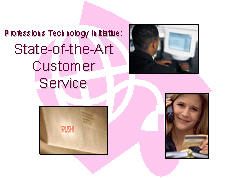
A multi-phased
technology initiative will integrate licensing services in the Office of the
Professions. Customers—licensed
professionals, consumers, employers, applicants, associations and others—will
be able to access comprehensive print, phone, and Web-based services. Building on existing process improvements,
the system will help to maximize efficiencies and enhance staff-assisted
and self-service contacts.
Services:
·
Apply
for—and renew—professional licenses/permits online
·
Pay
fees electronically
·
Securely access application and licensure
records using a PIN number
·
Expanded access to consumer information
on the professions
·
Up-to-date practice information for
licensed professionals
Advantages:
·
Efficient, integrated, and accessible
services
·
Faster licensure and discipline actions
·
Enhanced e-options for customers
·
Paper reduction: paperless
transactions, e-file reviews, and document management
·
Improved searches of professional
disciplinary actions and e-filing of misconduct complaints
These advantages, coupled with our traditional services, enhance
public protection. This is why the
Office of Technology ranks this initiative among its Top 75 Priority Service
Transactions in New York State.
Requested Resources
·
No additional funds or appropriation
authority are requested.
Regents Goal 3
“The public will be served by qualified, ethical professionals who
remain current with best practice in their fields and reflect the diversity of
New York State.”
Protecting the
Public from Unlicensed Practice of the Professions
Imagine you are conferring with a health care
professional.
Imagine you are stuck in a traffic jam, backed up on
a bridge.
Imagine you are meeting with a CPA to assess the
details of your spouse's small business.
Now imagine if that medical professional was a
fraud…or if that bridge's construction did not incorporate the principles
applied by design professionals…or if that "CPA" managed the
financial health of your family without having the education or experience to
do so. When non-licensees provide
services restricted to licensees, people get hurt.
For civil prosecution of these dangerous
practitioners, the Department's Office of the Professions (OP) will need to
establish an entirely new operation with specialized staff to support and
manage civil prosecutions: undercover investigators, translators, and hearing
officers, among others.
The New
Process
The
law sets a lengthy, multistage process:
NEW - If an
investigation substantiates a complaint, the Office will pursue a formal
cease and desist order.
NEW
- OP
must establish a hearing process for contested cases, since alleged
violators will have a right to a
hearing, with two additional opportunities to appeal.
NEW - Cases that proceed to hearings will require hearing officers, either employed by or contracted for and paid by the Department.
NEW
- To
ensure the effectiveness of cease and desist orders, OP will need a new system
to monitor compliance.
NEW
- Along
with monitoring compliance, OP will need to track actions and collect fines (up to
$5,000 per violation) and restitution. This includes going to court
to enforce cease and desist orders, restitution,
and civil penalties.
Demand, Resources, & Support
We
anticipate the number of illegal practice complaints will at least double
from the current 600, and the law will likely yield at least 100 hearing cases
annually. The expectation in the field
is that OP's pursuit of illegal practice will be as aggressive as its pursuit
of misconduct by licensed professionals.
COMPLAINTS OF PROFESSIONAL MISCONDUCT AND UNLICENSED PRACTICE RECEIVED
ANNUALLY
(Projection: Almost a 40% increase from ’98 – ’03
average)
1998
5,998
1999
6,842
2000
8,252
2001
7,490
2002
7,616
2003
7,134
2007
* 10,000
* Minimum projection, based on implementing the new mental health
therapy professions and the civil prosecution of illegal practice.
Two million dollars
will be needed to implement the law. That includes funding for
new staff members (coordinator, investigators, attorneys, legal assistants,
etc.) and undercover investigators, expert consultants, travel, stenographic
transcripts, equipment and more.
Requested Resources
- $2 million in
additional annual spending authority.
Revenue to be generated by a dedicated surcharge.
2005-2006
PROPOSED BUDGET
INITIATIVES
Regents Goal 4
“Education,
information and cultural resources will be available and accessible to all
people.”
New
Century Libraries: Investing in 21st Century Libraries
The New Century Libraries initiative
will help New York State achieve higher learning standards, address the
problems of urban/high-needs areas, and develop a skilled and productive
workforce. It will provide New Yorkers with equitable access to the quality
library services they need now and in the future.
NOVEL: A Critical Resource
for New Yorkers in the Information Age
NOVEL (New York Online Virtual Electronic Library) is an integral part of this initiative and a critical resource for New Yorkers. It is New York’s first statewide virtual library, or “library without walls.” By March 2004, 4,792 libraries were actively using the pilot NOVEL databases program, which is supported by temporary Federal funds. Use of NOVEL databases has soared 3500 percent. However, libraries need ongoing support for updated technology and staff training to meet increasing public demand for access to NOVEL in the library, from home, school, or work.
NOVEL cannot continue to depend solely on temporary Federal funding. Without sustained State funding, some NOVEL databases may be lost as soon as late 2005.
NOVEL is a smart investment. Through NOVEL, libraries are able to provide the high-quality, reliable sources of electronic information that New Yorkers need at tremendous cost savings to their communities and libraries. For example, online databases purchased through NOVEL could cost localities 30 times as much to purchase on their own. If NOVEL were funded at the requested level, savings to local libraries would exceed $150 million.
Requested Resources for FY
2005-2006: $107 million
·
$14 million
for NOVEL (aid to localities)
·
$20 million
for Library Construction Grants (capital)
·
$73 million
for additional resources requested in the New Century Libraries initiative (aid
to localities)
Public Library Construction
Grants: Investing in a Community Resource
New Century Libraries proposes that in 2005–06 the State invest $20 million in public library construction to renovate and upgrade public library facilities, enabling them to be accessible to New Yorkers with disabilities and accommodate new computer and Internet technologies. Particularly in disadvantaged areas, libraries are centers of community life that promote information literacy and afford opportunities for lifelong learning.
Additional Aid to Localities for 21st Century Library
Service:
-
$10 million to help more libraries move to the public library district model
-
$18 million to strengthen and support school libraries
-
$10.2 million to increase library hours for urban neighborhoods and fund programs to help new Americans
-
$16 million to ensure a minimum level of $20 per capita in support for public libraries and a program of incentives to achieve excellence
-
$1 million to strengthen library literacy and reading programs for adults and families
-
$2 million to recruit a new generation of skilled librarians
-
$15.1 million to increase access to the resources of the State’s academic, special, and research libraries for all New York’s students and faculty
-
$.7 million to strengthen library services for individuals with disabilities.
Future Budgetary Needs
Regents Goal 4
"Education, information and cultural resources
will be available and accessible to all people."
Public
Television in the Digital Age
Requested Resources
Digital Transition $25
million
Total $25 million
Digital Transition
Phase I (completed): By May 2003 public television
stations were required to broadcast a digital signal.
Phase
II: By May 2006 public television
stations must be fully operational in digital and must relinquish their analog
signals.
Empire Central
The
public broadcasting stations are committed to establishing the Empire Channel,
a totally dedicated education channel with interactivity and on-demand
programming. Professional development
for educators, with downloadable material, programming for parents and
programming targeted to the disability community would be part.
Benefits
·
fulfills required FCC
mandates for digital conversion
·
insures access of
public television to all New Yorkers
·
establishes a statewide
education channel
·
maintains local control
and content of public television
·
provides operational
efficiencies and cost savings
·
generates Federal and
private funding
Regents Goal 5
"Resources
under our care will be used or maintained in the public interest."
NYS
Museum Renewal
Since
1836 the New York State Museum has collected and interpreted the State's
natural and cultural legacy. Museum researchers have been pioneers in the
investigation of the natural and human history of New York. The Museum's vast collections represent some
11,500 years of human activity.
The Need
Recent
capital funding appropriations have led to great improvements in the Museum
galleries but many remaining museum exhibitions on the first floor are “tired.”
The exhibits contain dated information, use little or no technology, do not
represent the ethnic and racial diversity of the State and do not make use of
the Museum's important collections.
Exhibition Renewal Overview
The Museum's disciplines of geology, biology, anthropology and
history will be featured in presentations of integrated exhibit stories about
the State's natural and human past and their connections to the present. While
the main exhibits will serve as a window on New York, the temporary exhibits
will continue to bring the world to New York.
The
new exhibitions will be more interactive, will employ as wide a range of
exhibit techniques, approaches and media as possible and will use the Museum's
collections more intensively.
Requested
Resources:
No additional funds are requested.
·
The entire project will
cost $50 million and take 10 years to complete.
·
$10 million of the $50
million will be raised through a capital campaign fund.
·
$5 million
appropriation authority is requested for 2005-06 to initiate the first major
phase and for the next phases.
Statutorily
Mandated Needs:
Aid
to Libraries –
Education
Law Sections 271, 272, 273, 273-a, 284 and 285 provide general aid to
libraries, including the 74 library systems, central libraries in public
library systems, all 744 member public libraries, some 216 academic libraries
and several special libraries such as the New York State Library’s Talking Book
and Braille Library serving 39,000 readers with disabling conditions in 55
upstate counties.
With
the implementation of the 2000 census, an additional $2.4 million for a total
of $91.3 million is required to fund the full statutory level.
The
Department is also proposing separate legislation to provide formula
stabilization to ensure no library or system receives less than the amount
received in 2001-2002 for those programs negatively impacted by the 2000 census
for a total cost of $200,000.
Aid
to Public Radio and Television –
Section
236 of the Education Law provides aid to 17 public radio and 9 public
television stations. In 2002-2003 the
State appropriated approximately 52 percent of the funding called for under the
statute.
An
additional $12.7 million for a total of $26.5 million is required to fully fund
the statutory level.
2005-2006
PROPOSED
BUDGET INITIATIVES
Priority Budget Initiatives
Regents Goal 4
“Education, information, and cultural resources
will be available and accessible to all people.”
VESID Employment
and Independence Initiative – Regents Priority Initiative
I. Integrated
Employment: $6 Million
VESID produces
jobs for persons with disabilities in New York State. Funding is needed to sustain services for eligible consumers and
to generate the benefits that come from employing people with disabilities.
Individuals with disabilities going to work support New York State. In 2003,
15,010 individuals with disabilities were placed in employment by VESID
resulting in $225 million in annualized earnings that are returned to the
community. In the last five years,
VESID has helped reduce reliance on public benefits by assisting over 17,500
welfare recipients in obtaining employment.
The employment of these individuals increased tax revenues and savings
in public benefits. Over the last six years, VESID’s active caseload grew by
nearly 5%. The average cost per consumer served has risen by 3.35% over the
same period. The Medicaid Buy-in Option, which allows current SSI and SSDI
recipients to continue receiving health benefits while earning larger amounts
of money, has the potential to generate a large increase in people needing
VESID services.
The benefits of
serving these additional consumers include:
Annualized Earnings - $13.5
Million
II.
Supported
Employment: $8 Million
VESID is seeking capacity to serve an additional 1,000
individuals with severe disabilities and place them in integrated job settings
that are more cost-effective. This will
enable individuals with significant disabilities to move into employment and
community participation. The average intensive cost for placing an individual
in Supported Employment is much less than the comparable cost of less
integrated day services at OMRDD and OMH.
The fiscal benefits of placing these additional individuals
into employment include:
Annualized Earnings - $10
Million
Requested
Resources
·
Integrated Employment - $6 million to restore Executive Budget reductions, Cost of Living
increases to community-based rehabilitation agencies, to serve additional
consumers due to outreach, the Workforce Investment Act and Welfare Reform to
continue progress toward the goal of 20,000 job placements per year.
·
Supported Employment - $8 million to open up
services for approximately 1,000 of the most severely disabled individuals.
Regents/SUNY/CUNY Joint Budget Initiative
I. Postsecondary Education and
Disabilities: $15.0 Million
A high school diploma is no longer sufficient to ensure
individuals with disabilities competitive employment; in many cases a college
education is necessary. Approximately
50% of students with disabilities and 20% of individuals with disabilities over
the age of 21 will access postsecondary education next year and will continue
to grow. Over 2 billion dollars in
school aid are allocated annually to support students with disabilities (3-21
years of age) to prepare them for future employment. To further this effort of enhanced employment opportunities,
increased access to postsecondary education is needed by funding programs for
the improvement of disability services at institutions of higher education.
The lack of
college and university support services for students with disabilities, coupled
with physical barrier to full access to campuses, have worked together to deny
many potential students the opportunity to pursue a postsecondary education.
This proposal, generated from recommendations made by
the Task Force on Postsecondary Education and Individuals with Disabilities,
was developed in consultation with representatives of SUNY, CUNY, the
independent colleges and universities, and the degree-granting proprietary
colleges.
Requested Resources
$15 million to:
·
Provide base funding for capacity building.
·
Support the development of programmatic activities.
·
Support
recruitment programs that establish targets for recruitment of students with
disabilities.
REGENTS BUDGET INITIATIVE: VOCATIONAL AND EDUCATIONAL SERVICES FOR INDIVIDUALS WITH DISABILITIES
VESID Employment and Independence Initiative
Numbers of People with
Disabilities Placed in Employment
by VESID
and Their Annualized Earnings
Total Placements = 15,010
Total Annualized Earnings = $224,821,067
Federal Fiscal Year 2003
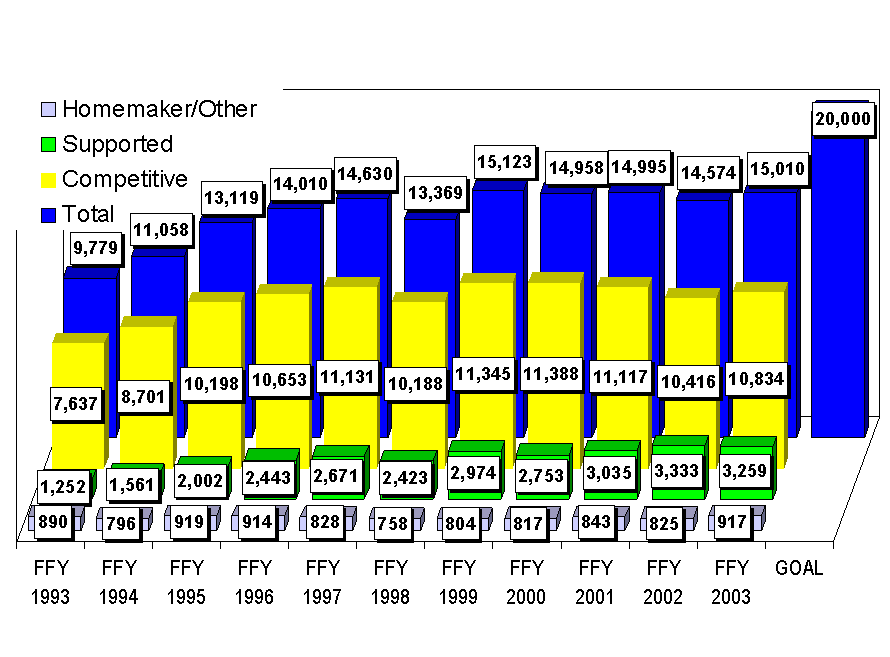
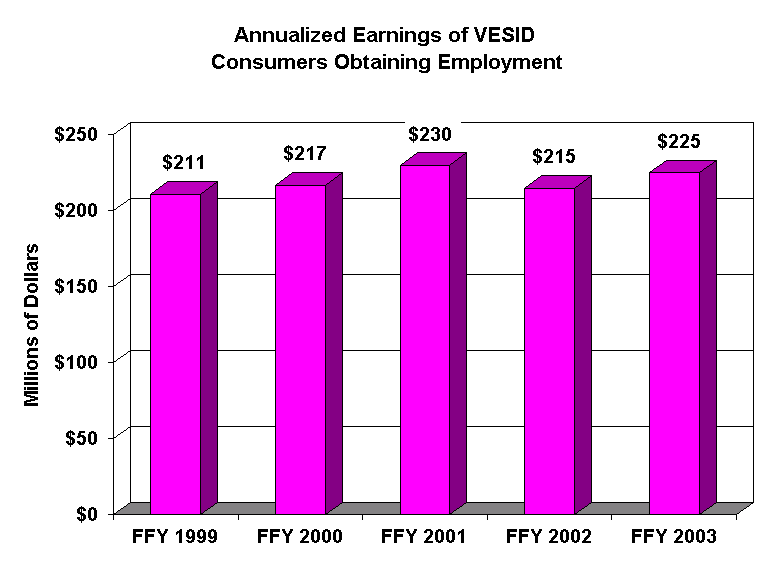
Greater percentages of students with disabilities are planning to
pursue college after high school. Of the students with disabilities
who completed high school, 48.5 percent had plans to pursue
a college education.
Postsecondary plans of students with disabilities
who completed high school*
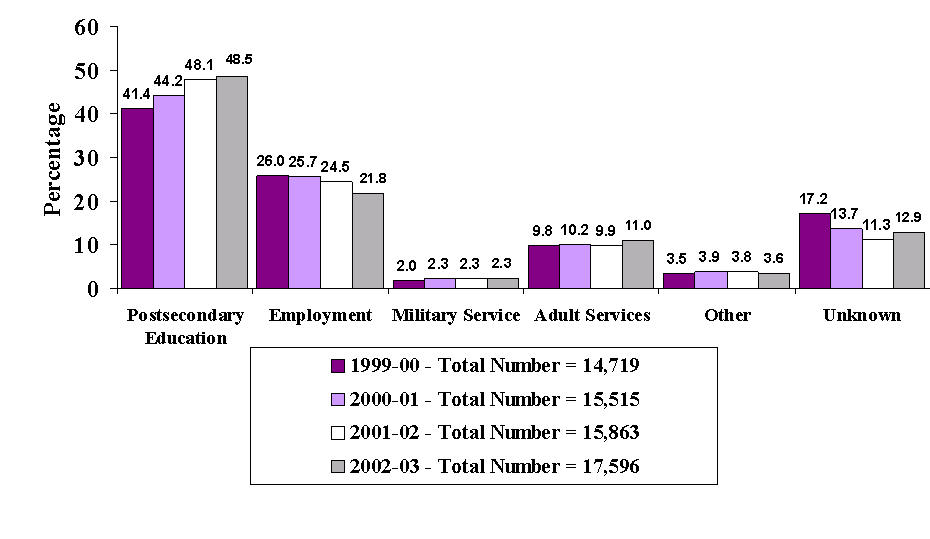
The Enrollment of Self-identified students with disabilities in higher education
programs has been increasing steadily.
Enrollment of Individuals with Disabilities*
1997 - 28,174 - 2.8 %
1999 - 30,593 - 3.0%
2000 - 34,041 - 3.3%
2001 - 36,060 - 3.4%
2002 - 38,012 - 3.5%
*Data
for 1998 are not available
Future
Budgetary Needs
Regents Goal 4
“Education, information, and cultural
resources will be available and accessible to all people.”
VESID
Employment and Independence Initiative – Additional Budgetary Needs
I.
Independent Living:
$1.0 Million
New
York’s 36 Independent Living Centers serve over 72,000 individuals and
thousands of businesses throughout New York State. They have become the primary resource for information necessary
to enhance community integration of people with disabilities, increase physical
and communication access and remove disincentives to work. Independent Living Centers remain
instrumental in facilitating implementation of the U.S. Supreme Court’s
Olmstead Decision, creating strategies with school districts to enhance
transition planning and services for youth with disabilities, and increasing
access to new and emerging employment options under the Workforce Investment
Act and New York’s Medicaid Buy-in programs.
Independent Living Centers continue to be the only consumer controlled,
community based, nonresidential, not-for-profit network in New York State
operating based on a self-help, peer driven model.
II.
Readers Aid: $200,000
The Readers Aid program
provides reimbursement to Institutions of Higher Education for the cost of
providing interpreters, readers or note-takers for eligible students who are
deaf, deaf-blind or blind; are residents of New York State; and are
matriculated in a degree-granting program.
Institutions of Higher Education are eligible to receive up to $1,000
($500 per academic semester) to provide access to these services for eligible
students vital to their studies, enabling students to succeed academically.
There are 460 New York State students enrolled in this program, or 160 more than can be supported through the current annual appropriation of $300,000. This request is only a small portion of the total cost for interpreters, readers and note-takers for all New York State residents who are deaf, deaf-blind or blind and are enrolled in New York State Institutions of Higher Education.
Requested
Resources
·
Independent Living - $1.0 million to
maintain the services provided to individuals with disabilities by the 36
Independent Living Centers across the State.
·
Reader’s Aid - $200,000 for reimbursement to Institutions of Higher
Education for the cost of providing interpreters, readers or note-takers for
eligible students who are deaf, deaf-blind or blind. The Institutions of Higher Education are eligible to receive up to $1,000 ($500 per academic semester) for each
eligible student for these services.
Special Education Services - Statutorily Mandated
Needs
Allowance to Private Schools for
the Blind and Deaf (4201)
To support
private schools for the education of students, who are deaf, blind or severely
orthopedically disabled as required by section 4201 of the Education Law, including an assessment
on raising standards. The appropriation
requested also provides for State reimbursement of education costs for deaf
infants below the age of three attending programs approved by the Commissioner
at various public and private settings.
The requested additional funding of $3,800,000 represents a 2.7% COLA.
Education of Children with Disabilities – Preschool (4410)
To support the education of preschool children with disabilities consistent with federal and State requirements. The requested additional funding of $16,586,000 represents a 3.0% COLA.
